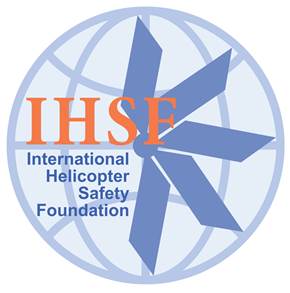In an effort to group and identify technology items deemed most likely to eliminate helicopter accidents, the International Helicopter Safety Foundation has compiled a list of key safety tools based on recommendations from the U.S. Helicopter Safety Team and the European Safety Promotion Network-Rotorcraft.
The technology working group within the IHSF, composed of representatives from industry and government, have completed a report, “Combined USHST and ESPN-R Helicopter Safety Technology Emphasis Items,” that categorizes technology items in the following way:
- Group one: Available and mature flight deck technologies.
- Group two: Emerging or advancing technologies.
- Group three: Technologies for improved operational control, risk management and aircrew preparedness.
Crash survivability technology items were specifically omitted as the group’s focus is set on accident prevention.
In order to address the problem of helicopter accidents holistically, the IHSF is looking at technology solutions and potential solutions beyond the aircraft and direct flight operations. It is reaching into potential technology areas that could improve safety by changing how helicopters are used and flown, and how risks can be better managed industry-wide. The report is intended to serve as a resource for operators who are deciding how to equip their helicopters, for customers and insurers who are contemplating what safety-enhancing technology to mandate, and for helicopter manufacturers who are determining what equipment to offer as standard or optional on their aircraft.
Fifteen technologies are highlighted in the report:
Group one: Available and mature flight deck technologies
- Automatic flight control systems (AFCS);
- Data-derived terrain and obstacle detection systems;
- Synthetic vision systems (SVS).
Group two: Emerging or advancing technologies
- Cost-Effective IFR Certification/Synthesis of technologies;
- ADS-B “Out” and “In”;
- “e-Conspicuity” devices;
- Air data sensing systems;
- Active terrain, obstacle and traffic detection;
- Lightweight health and usage monitoring system (HUMS) warning systems.
Group three: Technologies for improved operational control, risk management and aircrew preparedness
- App-based “smart” flight risk assessment tool (FRAT);
- Flight simulation training devices – helicopter (FSTD-H);
- Flight briefing/preparation/debriefing app/software applications;
- Helicopter flight data monitoring systems (HFDM);
- Flight operations quality assurance (FOQA);
- Optionally piloted aircraft (OPA) and unmanned aircraft systems (UAS).
As an adjunct to this paper, the IHSF’s technology working group authored and distributed a “Safety Technologies” survey and obtained nearly 1,400 responses from helicopter pilots worldwide. In addition, the survey was independently translated and redistributed in Japan with several hundred additional responses. This survey’s data is currently being analyzed by IHSF members and promises to yield insights into a broad cross section of attitudes on a variety of areas of interest such as single pilot instrument flight rules (IFR) operations, IFR operations in a single-engine aircraft, IFR proficiency, and the perceived efficacy of commonly used safety technologies. The IHSF will publish results from this survey later this year.









